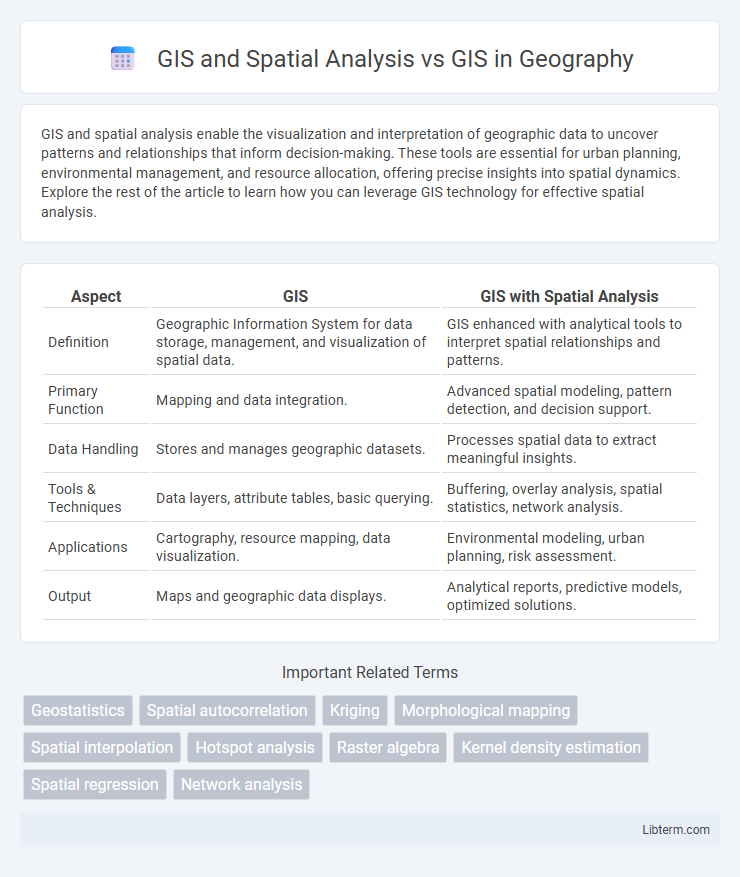GIS and spatial analysis enable the visualization and interpretation of geographic data to uncover patterns and relationships that inform decision-making. These tools are essential for urban planning, environmental management, and resource allocation, offering precise insights into spatial dynamics. Explore the rest of the article to learn how you can leverage GIS technology for effective spatial analysis.
Table of Comparison
| Aspect | GIS | GIS with Spatial Analysis |
|---|---|---|
| Definition | Geographic Information System for data storage, management, and visualization of spatial data. | GIS enhanced with analytical tools to interpret spatial relationships and patterns. |
| Primary Function | Mapping and data integration. | Advanced spatial modeling, pattern detection, and decision support. |
| Data Handling | Stores and manages geographic datasets. | Processes spatial data to extract meaningful insights. |
| Tools & Techniques | Data layers, attribute tables, basic querying. | Buffering, overlay analysis, spatial statistics, network analysis. |
| Applications | Cartography, resource mapping, data visualization. | Environmental modeling, urban planning, risk assessment. |
| Output | Maps and geographic data displays. | Analytical reports, predictive models, optimized solutions. |
Introduction to GIS and Spatial Analysis
GIS (Geographic Information Systems) involves capturing, storing, and managing spatial data, enabling detailed mapping and visualization of geographic information. Spatial Analysis extends GIS by applying statistical and computational techniques to interpret spatial patterns, relationships, and trends within the data. The integration of GIS and Spatial Analysis enhances decision-making processes in urban planning, environmental management, and resource allocation through precise geographic insights.
Defining GIS: Core Functions and Capabilities
Geographic Information Systems (GIS) are designed to capture, store, manipulate, analyze, and visualize spatial and geographic data. Core functions of GIS include spatial data integration, query and analysis, mapping, and geoprocessing, which enable effective decision-making based on location context. Spatial analysis, a specialized GIS function, focuses on examining spatial relationships and patterns through techniques like overlay, buffering, and network analysis.
What is Spatial Analysis in GIS?
Spatial analysis in GIS involves the examination of geographic patterns to interpret relationships, trends, and spatial phenomena within mapped data. It employs techniques such as overlay, buffering, and spatial interpolation to analyze location-based information, enabling informed decision-making in urban planning, environmental management, and resource allocation. GIS integrates spatial analysis tools with geographic data to visualize, model, and quantify spatial relationships effectively.
Key Differences Between GIS and Spatial Analysis
GIS (Geographic Information System) is a comprehensive framework for capturing, storing, managing, and visualizing spatial data, enabling users to create detailed maps and integrate various geographic datasets. Spatial analysis refers specifically to the quantitative techniques applied within GIS to examine spatial relationships, patterns, and trends, such as proximity analysis, overlay analysis, and spatial statistics. Key differences lie in GIS as the platform or toolset for handling geospatial data, while spatial analysis represents the analytical processes that extract meaningful insights from that geospatial data.
Integration of Spatial Analysis within GIS Workflows
GIS integrates spatial analysis directly into workflows by enabling the seamless processing, visualization, and interpretation of geospatial data. This integration streamlines decision-making across sectors such as urban planning, environmental monitoring, and resource management through advanced tools like spatial statistics, overlay analysis, and network modeling. Embedding spatial analysis within GIS optimizes data accuracy, enhances predictive capabilities, and facilitates real-time geospatial insights essential for complex spatial problem-solving.
GIS Tools for Advanced Spatial Analysis
GIS tools for advanced spatial analysis enable precise data modeling, visualization, and geoprocessing to uncover spatial patterns and relationships. These tools include spatial statistical functions, 3D terrain modeling, network analysis, and raster analysis, enhancing decision-making across urban planning, environmental management, and resource allocation. Leveraging powerful software such as ArcGIS Pro, QGIS, and spatial databases optimizes the handling of complex spatial datasets for in-depth geographic insights.
Common Applications: GIS Alone vs. GIS with Spatial Analysis
GIS alone facilitates basic mapping, data visualization, and geographic data management for urban planning, resource allocation, and infrastructure monitoring. GIS with spatial analysis enhances decision-making by integrating spatial statistics, pattern recognition, and predictive modeling to address complex problems in environmental management, epidemiology, and transportation optimization. Common applications of GIS with spatial analysis include hotspot detection, land suitability analysis, and spatial autocorrelation assessment, which provide deeper insights than standard GIS mapping.
Benefits of Using Spatial Analysis in GIS
Spatial analysis in GIS enhances decision-making by providing detailed insights into spatial patterns and relationships, enabling more accurate resource management and urban planning. It allows users to perform complex queries, model geographic phenomena, and predict trends based on spatial data layers, increasing the precision of analyses. Integrating spatial analysis with GIS supports efficient problem-solving across various sectors, including environmental management, transportation, and public health.
Challenges and Limitations: GIS vs. Spatial Analysis
GIS faces challenges in data integration and accuracy due to heterogeneous data sources and varying scales, which can lead to inconsistent results. Spatial analysis further complicates this by requiring advanced computational methods and expertise to interpret complex spatial patterns, often limited by software capabilities and data resolution. Both are constrained by data availability, processing power, and the need for skilled personnel to ensure meaningful and reliable geographic insights.
Future Trends in GIS and Spatial Analysis
GIS and Spatial Analysis are increasingly integrated with AI and machine learning to enhance predictive modeling and automated data interpretation. Advances in real-time spatial data processing and 3D geospatial visualization are revolutionizing urban planning and environmental monitoring. The future trends emphasize cloud-based GIS platforms, big data analytics, and augmented reality applications to support smarter decision-making and dynamic spatial analysis.
GIS and Spatial Analysis Infographic

 libterm.com
libterm.com